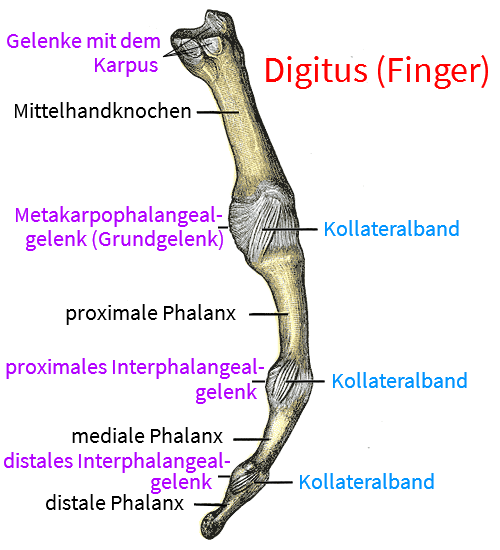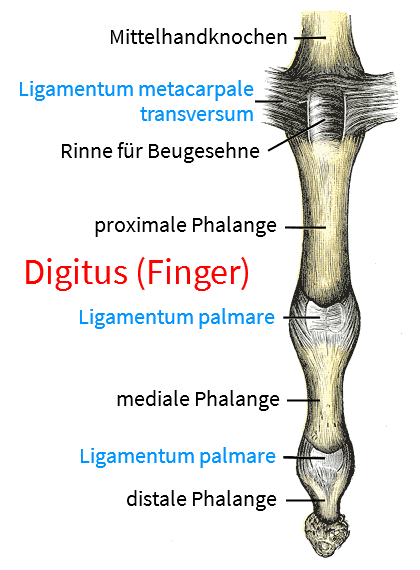yogabuch / gelenke / metacarpophalangeal joint
Contents
Image: Finger and finger joints from the side

Metacarpophalangeal joint
The metacarpophalangeal joints (articulationes metacarpophalangeae, MCP) are the joints in which the first(proximal) phalanges (phalanges) of the fingers move relative to the respective proximal heads of the metacarpal bones (caput ossis metacarpi). The metacarpophalangeal joints are stabilized laterally by collateral ligaments.
The basic joints are ball-and-socket joints; in addition to flexion and extension, radial and ulnar abduction/adduction are available. The rotation possible with ball-and-socket joints is restricted by ligaments. During flexion, whether active or passive, the collateral ligaments tighten, so that abduction and adduction are reduced depending on the degree of flexion; the same applies to hyperextension. The spreading of the fingers is caused by the interossei palmares, the interossei dorsales spread the fingers. The ligamenta metacarpalia transversa profunda and superficialia limit the possible spreading of the fingers.
The convex part is formed by the metacarpals, the proximal phalanges by the convex glenoid cavities. In contrast to the metacarpophalangeal joints, the dorsiflexion (extension) is limited to just over 0°; passively, a little more movement is possible. The approximately 90° available in the metatarsophalangeal joints of the toes is pathological in the metacarpophalangeal joints of the fingers, for example in the context of hypermobility syndrome. The range of motion of the metacarpophalangeal joints of the fingers in the direction of flexion extends actively to approx. 70-80°, passively to a good 90°.
The metacarpophalangeal joint of the thumb (articulatio metacarpophalangea pollicis), functionally a hinge joint, anatomically a condylar joint, primarily offers flexion and extension, the ROM is around 50°. Hardly any movement is possible in the direction of abduction, adduction and rotation. Collateral ligaments also exist in this joint.
Ligaments
For the ligaments, see the page on the finger joints
Pathology
For the ligaments, see the page on the finger joints
Tests
Tests of the MCP
Tests of the movement directions
Tests of the spanning muscles
Images
Finger joints from palmar

